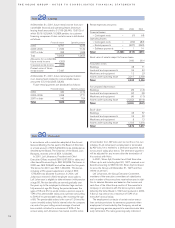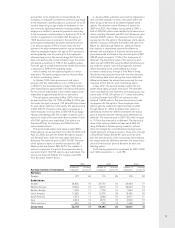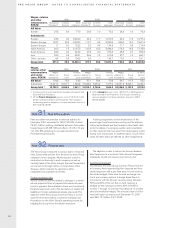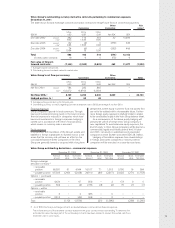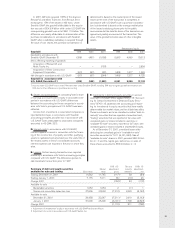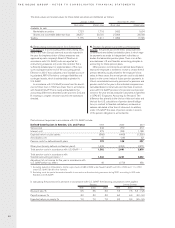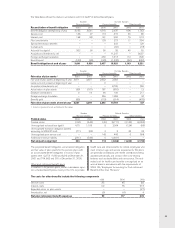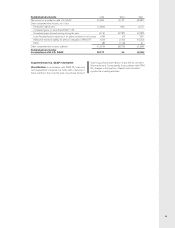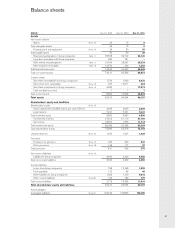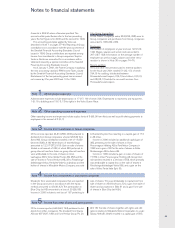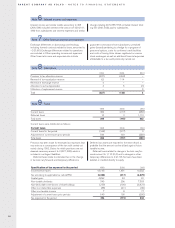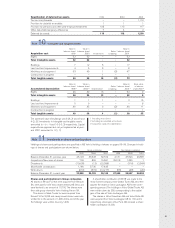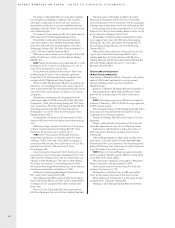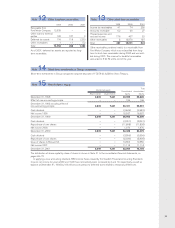Volvo 2001 Annual Report Download - page 88
Download and view the complete annual report
Please find page 88 of the 2001 Volvo annual report below. You can navigate through the pages in the report by either clicking on the pages listed below, or by using the keyword search tool below to find specific information within the annual report.
THE VOLVO GROUP · NOTES TO CONSOLIDATED FINANCIAL STATEMENTS
84
An increase of one percentage point per year in health-
care costs would change the accumulated post-retire-
ment benefit obligation as of December 31, 2001 by
approximately 206, and the net post-retirement benefit
expense by approximately 15. A decrease of 1% would
decrease the accumulated value of obligations by about
194 and reduce costs by approximately 14. In 2000, an
increase of 1% would increase the accumulated value of
obligations by about 81 and increase costs by about 7; a
decrease of 1% would reduce the accumulated value of
obligations by about 70 and cut costs by about 6.
Calculations made as of December 31, 2001 show an
annual increase of 12% in the weighted average per
capita costs of covered health-care benefits; it is
assumed that the percentage will decline gradually to
6% and then remain at that level.
The discount rates used in determining the accumu-
lated post-retirement benefit obligation as of December
31, 1999, 2000 and 2001 were 7.5%, 7.5% and 7.0–
7.25%, respectively.
I. Alecta surplus funds. In the mid-1990s and later years
surpluses arose in the Alecta insurance company (previ-
ously SPP) since the return on the management of ITP
pension plan exceeded the growth in pension obligations.
As a result of decisions in December 1998, Alecta dis-
tributed, company by company, the surpluses that had
arisen up to and including 1998. In accordance with a
statement issued by a special committee of the Swedish
Financial Accounting Standards Council, surplus funds
that were accumulated in Alecta should be reported in
companies when their present value can be calculated in
a reliable manner. The rules governing how the refund
was to be made were established in the spring of 2000
and an income amounting to 683 was included in the
Group’s income statement under Swedish GAAP during
2000. In accordance with U.S GAAP, the surplus funds
should be recognised in the income statement when they
are settled.
J. Software development. In accordance with U.S. GAAP
(SOP 98–1 “Accounting for the Costs of Computer
Software Developed or Obtained for Internal Use”)
expenditures for software development should be capital-
ized and amortized over the useful lives of the projects. In
Volvo’s accounting in accordance with U.S. GAAP, SOP
98-1 is applied as of January 1999. In Volvo’s accounts
prepared under Swedish GAAP up to and including
2000, expenditures for software development were
expensed as incurred. Effective in 2001, Volvo adopted
anew Swedish accounting standard, RR15 Intangible
assets. With regard to software development, the new
standard is substantially equivalent to U.S. GAAP and
consequently the difference between Swedish and U.S.
GAAP is pertaining only to expenditures for software
development during 1999 and 2000.
K. Product development. Effective in 2001, Volvo
adopted a new Swedish accounting standard, RR15
Intangible assets. In accordance with the new standard,
which comply in all significant respects to the corre-
sponding standard issued by the International Accounting
Standards Committee (IASC), expenditures for develop-
ment of new and existing products should be recognized
as intangible assets if such expenditures with a high
degree of certainty will result in future financial benefits
for the company. The acquisition value of such intangible
assets should be amortized over the useful lives of the
assets. In accordance with the new standard, no retro-
active application is allowed. Under U.S. GAAP, all expen-
ditures for development of new and existing products
should be expensed as incurred.
L. Entrance fees, aircraft engine programs. In connection
with its participation in aircraft engine programs, Volvo
Aero in certain cases pays an entrance fee. In Volvo’s
accounting these entrance fees are capitalized and amor-
tized over 5 to 10 years. In accordance with U.S. GAAP,
these entrance fees are expensed as incurred.


